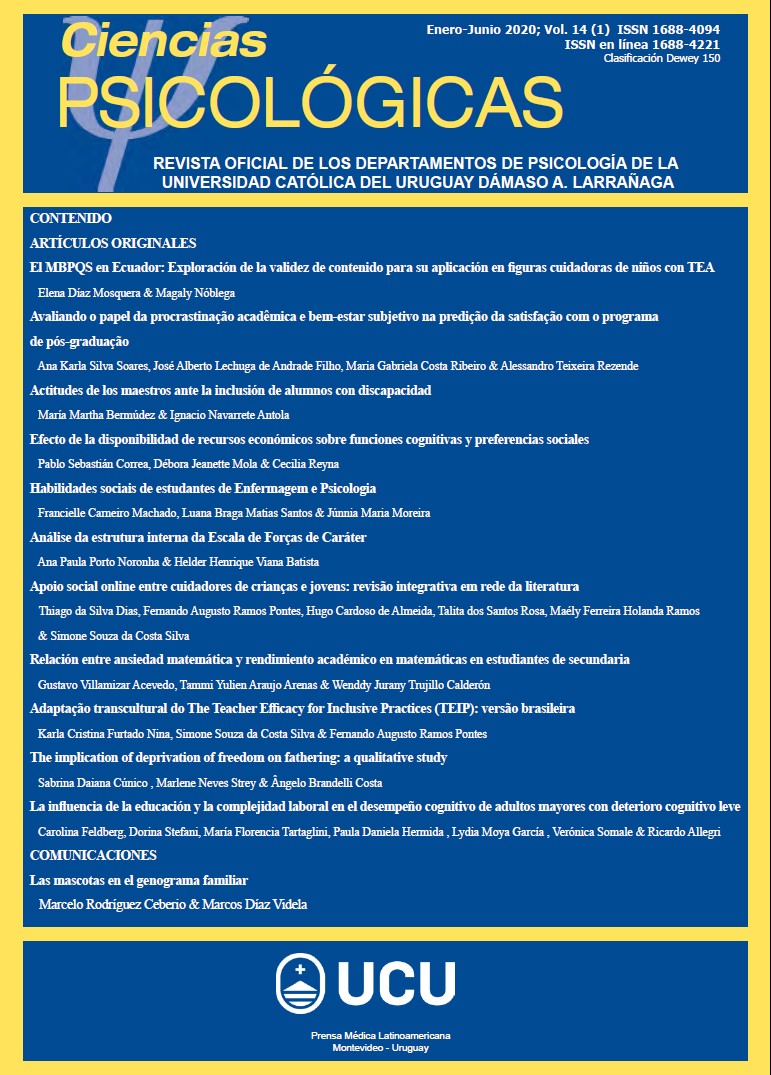Las mascotas en el genograma familiar
DOI:
https://doi.org/10.22235/cp.v14i1.2112Palabras clave:
animal de compañía, dinámica familiar, genograma, familia, psicoterapia, mascotaResumen
Los cambios socioculturales de las últimas décadas han posibilitado mayor permeabilidad a modelos familiares diversos y a la incorporación de integrantes no humanos. En occidente, el 90% de las personas tiende a considerar a sus animales como miembros de sus familias. Pese a la relevancia de esta configuración familiar humano-animal, en la práctica clínica, hasta recientemente, los animales parecen haber sido pasados por alto, por ejemplo, en la confección del genograma familiar. Si bien algunos autores han comenzado a incorporar a los animales a esta representación gráfica, la misma se ha mostrado problemática o poco estructurada. Fundamentándonos en las investigaciones previas, proporcionamos una guía para la inclusión de animales en el trazado de la estructura familiar, el registro de la información relacionada a estos, y de las relaciones familiares que los implican. Finalmente, realizamos una propuesta de incorporación de los animales en los talleres terapéuticos ligados al genograma.
Descargas
Citas
Bennett, P. C., & Rohlf, V. I. (2007). Owner-companion dog interactions: Relationships between demographic variables, potentially problematic behaviours, training engagement and shared activities. Applied Animal Behaviour Science, 102(1), 65-84. DOI: 10.1016/j.applanim.2006.03.009
Bennett, R. L., French, K. S., Resta, R. G., & Doyle, D. L. (2008). Standardized human pedigree nomenclature: update and assessment of the recommendations of the National Society of Genetic Counselors. Journal of genetic counseling, 17(5), 424-433.
Bennett, R. L., Steinhaus, K. A., Uhrich, S. B., O'Sullivan, C. K., Resta, R. G., Lochner-Doyle, D., ... & Hamanishi, J. (1995). Recommendations for standardized human pedigree nomenclature. Journal of Genetic Counseling, 4(4), 267-279.
Cain, A. O. (1985). Pets as family members. Marriage & Family Review, 8(3-4), 5-10.
Ceberio, M. R. (2005). Quién soy y de dónde vengo. El genograma: Un viaje por las interacciones y juegos familiares. Buenos Aires: Tres haches.
Charles, N., Davies, C., & Harris, C. (2008). Families in Transition: patterns of family formation and kinship networks. Bristol: The Policy Press.
Cohen, S. P. (2002). Can pets function as family members? Western Journal of Nursing Research, 24(6), 621-638. DOI: 10.1177/019394502320555386
Davis, L., Geikie, G., & Schamess, G. (1988). The use of genograms in a group for latency age children. International Journal of Group Psychotherapy, 38(2), 189–210.
Díaz Videla, M. (2017). Antrozoología y la relación humano-perro. Buenos Aires: iRojo.
Díaz Videla, M., & Olarte, M. A. (2017). Dogs' demographic characteristics associated with relationship differences perceived by the guardian. European Scientific Journal, 13(15), 218-232. DOI: 10.19044/esj.2017v13n15p%25p
European Pet Food Industry Federation (FEDIAF). (2017). Facts and figures. Disponible en: http://www.fediaf.org/who-we-are/european-statistics.html
García, E. (2015). Metaphoric generative genograms: A journey to bring genograms to life through metaphorical components. (Tesis doctoral). Nova Southeastern University, Florida
Global GfK Survey. (2016). Pet Ownership. Recuperado de: https://www.gfk.com/fileadmin/user_upload/country_one_pager/AR/documents/Global-GfK-survey_Pet-Ownership_2016.pdf
Herman, D. (2018). Narratology beyond the human: Storytelling and animal life. New York: Oxford University Press.
Hodgson, K., & Darling, M. (2011). Pets in the family: Practical approaches. Journal of the American Animal Hospital Association, 47(5), 299-305. DOI: 10.5326/JAAHA-MS-5695
Hodgson, K., Darling, M., Freeman, D., & Monavvari, A. (2017). Asking About Pets Enhances Patient Communication and Care: A Pilot Study. INQUIRY: The Journal of Health Care Organization, Provision, and Financing, 54, 1-6. DOI: 10.1177/0046958017734030.
Hodgson, K., Darling, M., Monavvari, A., & Freeman, D. (2018, 11 noviembre). Patient Education Tools: Using Pets to Empower Patients’ Self-care—A Pilot Study. Journal of Patient Experience. DOI: 10.1177/2374373518809008
Johnson, A., & Bruneau, L. (2019). Pets and relationships: How animals help us understand ourselves and our connections with others. En L. Kogan & K. Blazina (Eds.), Clinician's guide to treating companion animal issues (pp. 173-191). Londres, Reino Unido: Academic Press. DOI: 10.1016/B978-0-12-812962-3.00011-3
MacNamara, M., & Moga, J. (2014). The place and consequence of animals in contemporary social work practice. En T. Ryan (Ed.), Animals in social work (pp. 151-166). Londres, Reino Unido: Palgrave Macmillan.
McGoldrick, M. (2016). The genogram casebook: A clinical companion to genograms: Assessment and intervention. New York: WW Norton & Company.
McGoldrick, M., & Gerson, R. (1985). Genogramas en la evaluación familiar. Barcelona: Gedisa.
McGoldrick, M., Gerson, R., & Petry, S. (2008). Genograms: Assessment and intervention. New York: Norton.
Metcalf, L. (2011). The practice of marriage and family therapy. L. Metcalf (Ed.), Marriage and family therapy: A practice-oriented approach (pp. 1-20). New York: Springer Publishing Company.
Meyer, I., & Forkman, B. (2014). Dog and owner characteristics affecting the dog–owner relationship. Journal of Veterinary Behavior: Clinical Applications and Research, 9(4), 143-150. DOI: 10.1016/j.jveb.2014.03.002
Walsh, F. (2009). Human-animal bonds II: The role of pets in family systems and family therapy. Family Process, 48(4), 481-499. DOI: 10.1111/j.1545-5300.2009.01297.x
Descargas
Publicado
Cómo citar
Número
Sección
Licencia
Derechos de autor 2020 Universidad Católica del Uruguay

Esta obra está bajo una licencia internacional Creative Commons Atribución 4.0.
















